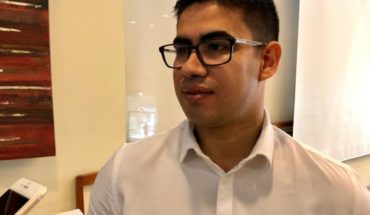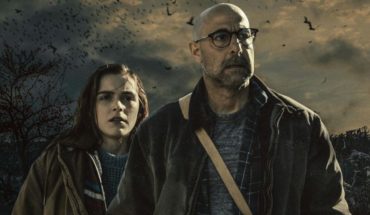Erika Martinez’s daughter was 7 years old when her stepfather’s brother sexually abused her. They all lived in the same house, so after the complaint, they also ran out of housing. Three years have passed and there is no justice, the alleged assailant remains free and Erika and her daughter have nowhere to live. That is why he now says that he will stay in the building of the National Commission on Human Rights (CNDH) of the Historic Center, taken since Friday by groups of victims and feminists, who claim that they will no longer return it because it will become a refuge.
It was just Erika’s daughter, now 10, who painted on the painting of Francisco I. Madero who was inside the Commission, an act that President Andrés Manuel López Obrador said at his morning conference on Monday that it was vandalism and that whoever did it is because he does not know the story or is a conservative.
“This painting, these flowers, these painted lips, my daughter painted them. My daughter, a girl who at 7 years old was sexually abused. So I want to tell that president that how he is outraged by this painting, why not be outraged when my daughter was abused?” cried Erika in front of the image.
Read: Vandalism: AMLO criticizes protest of women who took CNDH offices
At his side, other paintings by Miguel Hidalgo, José María Morelos and Benito Juárez, also intervened and exhibited head-on, “because everything is upside down in this country”, explained the protesters, in addition to offering to auction them to get some of the reparation of the damage they claim that the institutions have not given them. Erika, for example, said she only receives 300 peso support every three months, while continuing the legal process and homeless.
She was one of the visible faces of the protesters on Monday, along with Yesenia Zamudio, mother of Marichuy Jaimes, who was killed in 2016, who heads the Ni Una Menos Front, a feminist organization focused on femicides and other gender-based violence, which took the facility on Friday, after joining another protest that had begun on Wednesday.
Inside, they said, there are between 30 and 50 people, including girls and boys, relatives of missing persons, and younger girls of collectives such as Feminist Parenting, Feminist Student Movement or Violet Aquelarre, some of whom call themselves anarchists. These collectives set up a table as a collection center where commodity donations and even mats were arriving during the day, both for the women inside the building and to help victims, they said.
An agreement had been reached on Monday with a part of the families who remain within to have a dialogue with authorities of the CNDH and the Secretariat of the Interior (Segob), which ultimately did not materialized because it intended that it was the non-conforming ones to move to other offices, while the Commission authorities refused to go to the place of the takeover , on the grounds that there are other protesters who do not want to dialogue.
How did the protest begin?
María Isela Valdez became national news when she knelt before López Obrador in the National Palace to ask for justice in the case of her son Roberto Quiroa, who disappeared in Tamaulipas in 2014, and after which she promised “I will give it to you”, according to account. It’s been more than a year since the only time relatives of the missing were able to meet directly with the president, who was full of grievances, and in which he promised them that every three months they would review their cases, but none of that has happened.
So Maria Isela and other victims of the March 10 Collective set up a seed a few months ago at the door of the Executive Commission on Victim Care (CEAV) to demand decent treatment, among other demands.
You may be interested: In photos: Feminist take and against impunity of CNDH building
Last Wednesday, September 2nd, there was a meeting of that collective with the CNDH holder, Rosario Piedra Ibarra, attended by two other victims of San Luis Potosí: Marcela Alemán and Silvia Castillo, mothers of a child victim of sexual rape and a young man killed, respectively.
But as Piedra Ibarra told them that the folders were poorly integrated and would have to return to St. Louis, Marcela decided to tie herself to a chair, while Silvia aroused concern that she even threatened to kill herself, according to Delia Quiroa, daughter of Maria Icela and activist as well.
Then they spent the night inside the offices and outside began to go feminists to support the protest. Until Friday morning, the collectives entered, evicted the workers and reported that it was an occupation of the buildingto turn it into a victim’s shelter. The CNDH itself confirmed in a statement that on 2 and 3 September the Commission had worked normally and that it was until Friday 4 that its holder and workers were no longer able to enter.
The next day, the two women who had started the protest left, but the shot continued.
Yesenia Zamudio, of the Front Ni Una Menos, delinquered the decision-making of these two women, and accused that Piedra Ibarra abandoned them and that is why many other victims decided to take over the place. It further noted that similar shots from human rights offices or prosecutors’ offices, which did not investigate or resolve cases, are already being planned in other states.
Delia Quiroa, for her part, also delinquered her collective from Marcela and Silvia. She noted that there are currently five families of missing persons, who disagree on some of the acts committed by feminists.
That is why they had reached an agreement to discuss this Monday. A commission of five CNDH officials came to the gates of the takeover to transfer those who decided to participate to another Commission headquarters. But finally, the relatives of the disappeared decided not to separate from the rest of the protesters and stay inside the building, demanding that it be the authorities who come there.
Four days without agreements
The CNDH sent three communiqués throughout the day in which it sought an understanding, and that the heritage of the facilities be not damaged. But the members of Ni Una Menos demanded that these communiqués are only for the media or for their social networks, while no one in the Commission has made direct contact with them.
During the day, in addition to the paintings of historical characters on which they painted, CNDH plaques were ripped off, as one where men’s rights are discussed, in demand that women be unsusitized, and lit several fires in which they burned papers and pages of a book by López Obrador.
Read: They demand recommendation from CNDH against gender-based violence; keep taking
They threatened to give officials a day to go and get documents out and not burn them, although other activists clarified that victim files are inside locked offices. What they did take out over the weekend, they said, were cuts of meat and expensive cheeses that were stored in the dining room, such as to give a banquet, while the victims are not supported or to move to Mexico City to follow up on their cases.
The collective 10 March, for its part, already had a statement of commitments with the Commission, among which was to get them a meeting with prosecutor Alejandro Gertz Manero, meeting with the Under-Secretary for Human Rights of Segob Alejandro Encinas, and a public commitment that they will deal with respect for the victims. But since there was no pronouncement about it or the attempt to approach them, they felt that it was not being fulfilled.
Around 8 a.m. on Monday, CNDH officials waiting for a dialogue withdrew, while protesters collected the exhibits to protect them from the fledgling rain, and closed the doors of the building, where they remained sheltered one more night.
What we do at Animal Politics requires professional journalists, teamwork, dialogue with readers and something very important: independence. You can help us keep going. Be part of the team.
Subscribe to Animal Politics, receive benefits and support free journalism.#YoSoyAnimal
translated from Spanish: Who has taken the CNDH and how the protest began
September 8, 2020 |





